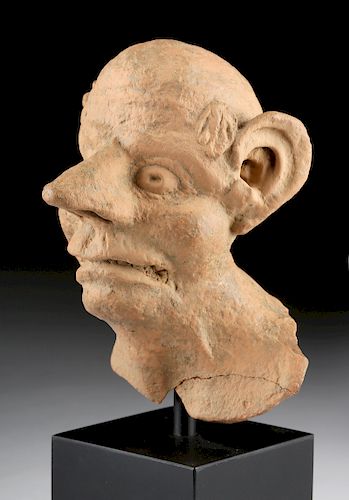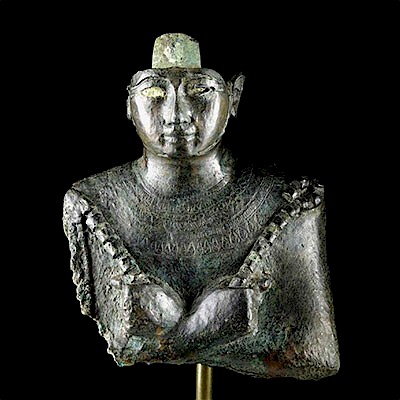Greek Hellenistic Terracotta Grotesque Bust - Comedy
Lot 36d
About Seller
Artemis Fine Arts
686 S Taylor Ave, Ste 106
Louisville, CO 80027
United States
Selling antiquities, ancient and ethnographic art online since 1993, Artemis Gallery specializes in Classical Antiquities (Egyptian, Greek, Roman, Near Eastern), Asian, Pre-Columbian, African / Tribal / Oceanographic art. Our extensive inventory includes pottery, stone, metal, wood, glass and textil...Read more
Estimate:
$1,200 - $1,800
Absentee vs Live bid
Two ways to bid:
- Leave a max absentee bid and the platform will bid on your behalf up to your maximum bid during the live auction.
- Bid live during the auction and your bids will be submitted real-time to the auctioneer.
Bid Increments
| Price | Bid Increment |
|---|---|
| $0 | $25 |
| $300 | $50 |
| $1,000 | $100 |
| $2,000 | $250 |
| $5,000 | $500 |
| $10,000 | $1,000 |
| $20,000 | $2,500 |
| $50,000 | $5,000 |
| $100,000 | $10,000 |
| $200,000 | $20,000 |
About Auction
By Artemis Fine Arts
May 22, 2019
Set Reminder
2019-05-22 10:00:00
2019-05-22 10:00:00
America/New_York
Bidsquare
Bidsquare : Exceptional Day 1: Antiquities Asian Fine Art
https://www.bidsquare.com/auctions/artemis-gallery/exceptional-day-1-antiquities-asian-fine-art-4129
Day 1 of an important 2-day auction featuring exceptional art from around the world - Egyptian, Greek, Etruscan, Roman, Viking, Russian, Near Eastern; Asian Art from China, Japan, Thailand, Vietnam, Burma, India; Fine Art from the 17th century to present. Artemis Fine Arts info@artemisgallery.com
Day 1 of an important 2-day auction featuring exceptional art from around the world - Egyptian, Greek, Etruscan, Roman, Viking, Russian, Near Eastern; Asian Art from China, Japan, Thailand, Vietnam, Burma, India; Fine Art from the 17th century to present. Artemis Fine Arts info@artemisgallery.com
- Lot Description
Greece, Hellenistic period, ca. late 4th to 2nd century BCE. A charming head, neck, and partial chest of a "grotesque" figure, with a bald head, deeply furrowed brow, giant ears and nose, small eyes, and a mouth in a deep grimace. Small tufts of hair are depicted at the temples. Grotesque depictions from the Hellenistic period are believed to relate to the tradition of New Comedy - the Greek form of situational comedy and comedy of manners, most notably written by Menander, Philemon, and Diphilus. A particular stock character from the New Comedy is Parasite, who according to the Oxford Classical Dictionary, plays this role: "Parasites attach themselves to their social superiors for their own advantage, above all for free meals; in return they flatter or entertain their patron, run errands, and suffer much ill-treatment." We know that they are often depicted as bald, middle-aged, and beardless, usually with a large nose and knitted brow - so this head likely represents this stock character. Size: 3.2" W x 4" H (8.1 cm x 10.2 cm); 6.55" H (16.6 cm) on included custom stand.
See a similar, but more crude, example at the Metropolitan Museum of Art: https://www.metmuseum.org/art/collection/search/252978
Provenance: private East Coast, USA collection
All items legal to buy/sell under U.S. Statute covering cultural patrimony Code 2600, CHAPTER 14, and are guaranteed to be as described or your money back.
A Certificate of Authenticity will accompany all winning bids.
We ship worldwide and handle all shipping in-house for your convenience.
#146207This is a fragment from a larger sculpture, lost below the shoulders. A small area of the neck has been repaired; otherwise it is in very nice condition, with well preserved details and light deposits on the surface.Condition
- Shipping Info
-
All shipping is handled in-house for your convenience. Your invoice from Artemis Gallery will include shipping calculation instructions. If in doubt, please inquire BEFORE bidding for estimated shipping costs for individual items.
-
- Buyer's Premium



 EUR
EUR CAD
CAD AUD
AUD GBP
GBP MXN
MXN HKD
HKD CNY
CNY MYR
MYR SEK
SEK SGD
SGD CHF
CHF THB
THB














